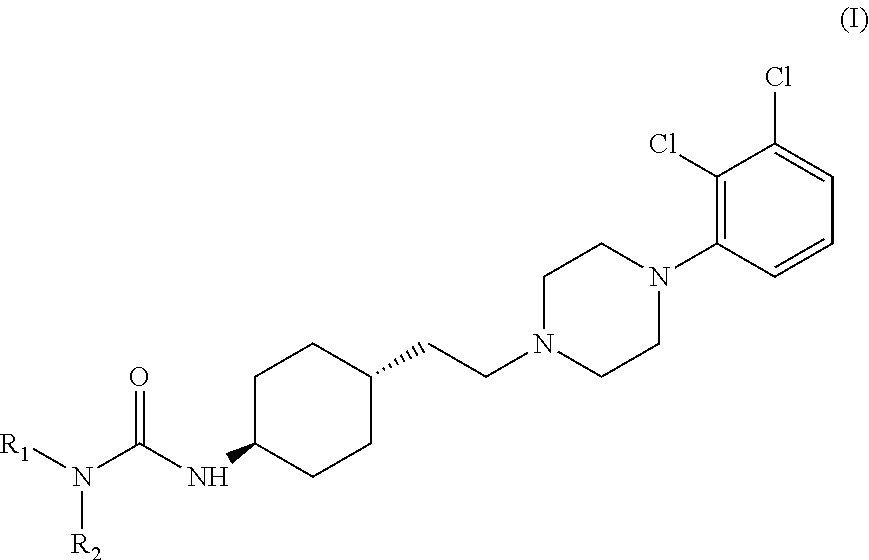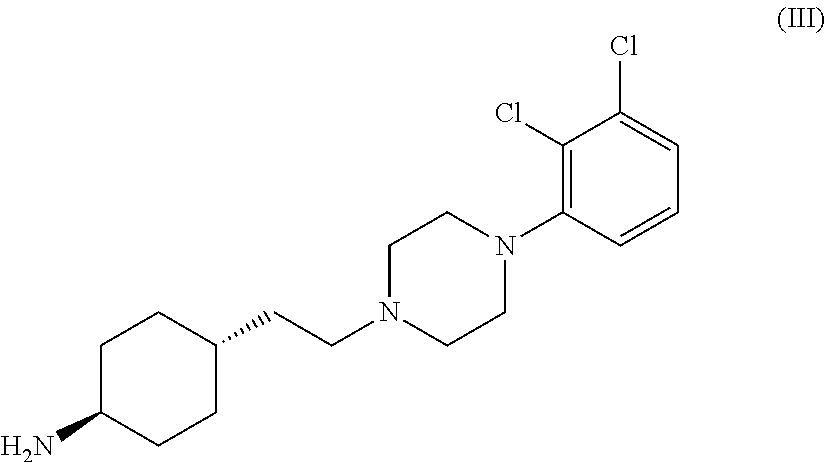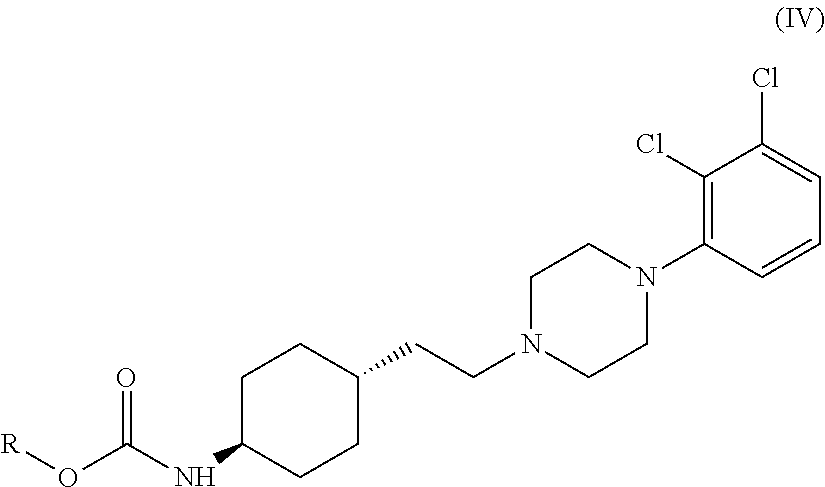Process for the preparation of piperazine compounds and hydrochloride salts thereof
a technology of hydrochloride salt and piperazine, which is applied in the field of preparation of piperazine compounds and hydrochloride salts thereof, can solve the problems of long reaction time (48 and 20 hours), poor yield (65%), etc., and achieve excellent yield
- Summary
- Abstract
- Description
- Claims
- Application Information
AI Technical Summary
Benefits of technology
Problems solved by technology
Method used
Image
Examples
example 1
Trans N-(4-{2-[4-(2,3-dichlorophenyl)-piperazine-1-yl]-ethyl}-cyclohexyl)-carbamic acid methylester
[0036]6.45 g (0.015 mol) of dihydrochloride of compound of formula (III) was added to a mixture of 125 ml dichloromethane and 12.25 ml triethylamine and the thick suspension obtained was stirred at a temperature between 20-25° C. for one hour. The so obtained suspension was added to a solution of 2.3 ml (0.03 mol) methyl chloroformate in 25 ml of dichloromethane at a temperature between 5-10° C. The reaction mixture obtained was stirred at a temperature between 20-25° C. for 3 hours then extracted with 3×150 ml (150 g) of distilled water. The organic phase was evaporated in vacuum and the residue was recrystallized from methanol. In this manner 4.5 g of the title product was obtained.
Yield: 72%.
[0037]Melting point: 143-147° C.
example 2
Trans N-(4-{2-[4-(2,3-dichlorophenyl)-piperazine-1-yl]-ethyl}-cyclohexyl)-carbamic acid isopropylester
[0038]6.45 g (0.015 mol) of dihydrochloride of compound of formula (III) was added to a mixture of 125 ml dichloromethane and 12.25 ml of triethylamine and the thick suspension obtained was stirred at a temperature between 20-25° C.-on for one hour. The suspension was added to a solution of 3.7 g (0.03 mol) of isopropyl chloroformate in 30 ml of toluene at a temperature between 5-10° C. The reaction mixture was stirred at a temperature between 20-25° C. for 3 hours and then extracted with 3×150 ml (150 g) of distilled water. The organic phase was evaporated in vacuum and the residue obtained was recrystallized from isopropanole.
[0039]In this manner 4,4 g of title compound was obtained.
Yield: 67%.
[0040]Melting point: 128-131° C.
example 3
Trans 4-{2-[4-(2,3-dichlorophenyl)-piperazine-1-yl]-ethyl}-N,N-dimethylcarbamoyl-cyclohexylamine
[0041]6.45 g (0.015 mol) of dihydrochloride of compound of formula (III) was added to a mixture of 125 ml of dichloromethane and 12.25 ml of triethylamine and the thick suspension obtained was stirred at a temperature between 20-25° C. for one hour. The suspension was added to a solution of 4.9 g of bis(trichloromethyl)carbonate in 50 ml of dichloromethane at a temperature between −5-(−10)° C. for one hour. The reaction mixture obtained was added to a solution of 13 g dimethylamine in 100 ml isopropyl alcohol (IPA) (40 ml, 0.12 mol) cooled at a temperature between 0-(−10)° C. during which the temperature of the reaction mixture was kept under 0° C. After stirring at a temperature between 0-(−5)° C. for 30 minutes to the reaction mixture 100 ml of distilled water was added under stirring. Then the pH of the aqueous phase was adjusted to 7-8 by adding concentrated hydrochloric acid and volu...
PUM
| Property | Measurement | Unit |
|---|---|---|
| acid | aaaaa | aaaaa |
Abstract
Description
Claims
Application Information
 Login to View More
Login to View More - R&D
- Intellectual Property
- Life Sciences
- Materials
- Tech Scout
- Unparalleled Data Quality
- Higher Quality Content
- 60% Fewer Hallucinations
Browse by: Latest US Patents, China's latest patents, Technical Efficacy Thesaurus, Application Domain, Technology Topic, Popular Technical Reports.
© 2025 PatSnap. All rights reserved.Legal|Privacy policy|Modern Slavery Act Transparency Statement|Sitemap|About US| Contact US: help@patsnap.com



